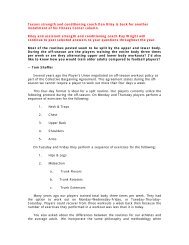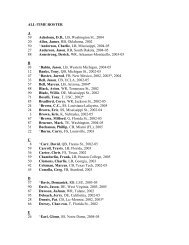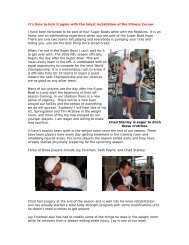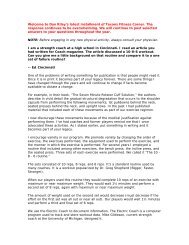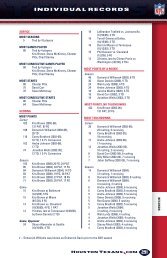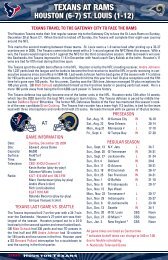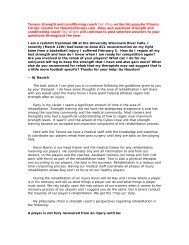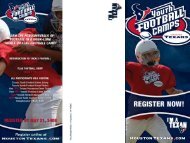HOUSTON TEXANS STRENGTH & CONDITIONING PROGRAM ...
HOUSTON TEXANS STRENGTH & CONDITIONING PROGRAM ...
HOUSTON TEXANS STRENGTH & CONDITIONING PROGRAM ...
You also want an ePaper? Increase the reach of your titles
YUMPU automatically turns print PDFs into web optimized ePapers that Google loves.
To determine if any activity has a positive impact on your speed, first get in great<br />
running shape. Lift, stretch, condition, and practice running fast. Periodically time<br />
yourself electronically. Eventually your increases in speed will level off. You simply<br />
can’t run any faster.<br />
At this point add one new activity to your training that you believe will improve your<br />
speed. After a short period of time you should observe an increase in your speed. If you<br />
do not, it’s obvious the new activity had no impact on improving your speed.<br />
Continue experimenting with only one activity at a time, until you’ve tried all the<br />
activities that purportedly improve speed. Don’t expect to begin the off-season out of<br />
shape and then perform a multitude of activities and expect to know which, if any,<br />
actually had an impact.<br />
Plyometrics<br />
Plyometric exercises incorporate a wide range of bounding, hopping, jumping,<br />
throwing, and explosive activities. The literature is quite specific on the effects of<br />
transfer. Skills do not transfer. Quickening exercises performed do not transfer from one<br />
task to another. You can become proficient at one-legged bounds by practicing onelegged<br />
bounds. Do not expect this skill or activity to transfer to movement performed on<br />
the football field.<br />
The game of football includes an endless number of explosive movements too<br />
numerous to document. The specific explosiveness used to perform each of these<br />
movements can only be developed by practicing these exact movements. If any<br />
plyometric exercise enhanced a skill or ability to play the game, it must be performed<br />
regularly during summer camp and throughout the entire season.<br />
Many of the explosive plyometric movements performed are quite stressful to the<br />
joints. Four preseason games, sixteen regular season games, and possibly four playoff<br />
games, are more stress than most athletes can absorb. You do not have the time or the<br />
energy to expend additional time and energy performing plyometric exercises during the<br />
season. If you are not going to perform them during the season...why perform them at<br />
all<br />
The formula is a simple one for a football player--and it doesn’t include any of the<br />
speed gadgets on the market.<br />
Speed training should not be confused with strength training, conditioning, or<br />
practice.<br />
* Use the weight room to develop muscular strength.<br />
* Use an interval running program to condition the heart, lungs, and<br />
muscles.<br />
* Practice the skills needed to run fast (stance, start, running technique).<br />
* Practice the skills used to play your position.<br />
You develop and maintain your specific football speed, quickness, and conditioning<br />
during summer camp and a 16-game season. The specific conditioning adaptations are<br />
developed by the activities you perform during practice and games.<br />
You don’t have the time or energy during the season to perform many of the activities<br />
often recommended to increase speed and explosiveness. You barely have enough time<br />
to recover between games.<br />
Anding/Riley/Wright 39



